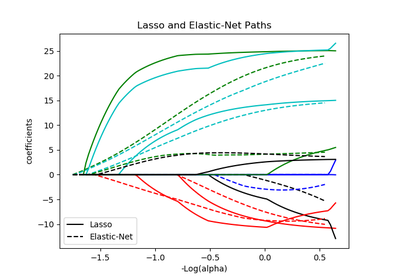sklearn.linear_model.lasso_path¶
-
sklearn.linear_model.lasso_path(X, y, eps=0.001, n_alphas=100, alphas=None, precompute=’auto’, Xy=None, copy_X=True, coef_init=None, verbose=False, return_n_iter=False, positive=False, **params)[source]¶ Compute Lasso path with coordinate descent
The Lasso optimization function varies for mono and multi-outputs.
For mono-output tasks it is:
(1 / (2 * n_samples)) * ||y - Xw||^2_2 + alpha * ||w||_1
For multi-output tasks it is:
(1 / (2 * n_samples)) * ||Y - XW||^2_Fro + alpha * ||W||_21
Where:
||W||_21 = \sum_i \sqrt{\sum_j w_{ij}^2}
i.e. the sum of norm of each row.
Read more in the User Guide.
Parameters: X : {array-like, sparse matrix}, shape (n_samples, n_features)
Training data. Pass directly as Fortran-contiguous data to avoid unnecessary memory duplication. If
yis mono-output thenXcan be sparse.y : ndarray, shape (n_samples,), or (n_samples, n_outputs)
Target values
eps : float, optional
Length of the path.
eps=1e-3means thatalpha_min / alpha_max = 1e-3n_alphas : int, optional
Number of alphas along the regularization path
alphas : ndarray, optional
List of alphas where to compute the models. If
Nonealphas are set automaticallyprecompute : True | False | ‘auto’ | array-like
Whether to use a precomputed Gram matrix to speed up calculations. If set to
'auto'let us decide. The Gram matrix can also be passed as argument.Xy : array-like, optional
Xy = np.dot(X.T, y) that can be precomputed. It is useful only when the Gram matrix is precomputed.
copy_X : boolean, optional, default True
If
True, X will be copied; else, it may be overwritten.coef_init : array, shape (n_features, ) | None
The initial values of the coefficients.
verbose : bool or integer
Amount of verbosity.
return_n_iter : bool
whether to return the number of iterations or not.
positive : bool, default False
If set to True, forces coefficients to be positive. (Only allowed when
y.ndim == 1).**params : kwargs
keyword arguments passed to the coordinate descent solver.
Returns: alphas : array, shape (n_alphas,)
The alphas along the path where models are computed.
coefs : array, shape (n_features, n_alphas) or (n_outputs, n_features, n_alphas)
Coefficients along the path.
dual_gaps : array, shape (n_alphas,)
The dual gaps at the end of the optimization for each alpha.
n_iters : array-like, shape (n_alphas,)
The number of iterations taken by the coordinate descent optimizer to reach the specified tolerance for each alpha.
See also
lars_path,Lasso,LassoLars,LassoCV,LassoLarsCV,sklearn.decomposition.sparse_encodeNotes
For an example, see examples/linear_model/plot_lasso_coordinate_descent_path.py.
To avoid unnecessary memory duplication the X argument of the fit method should be directly passed as a Fortran-contiguous numpy array.
Note that in certain cases, the Lars solver may be significantly faster to implement this functionality. In particular, linear interpolation can be used to retrieve model coefficients between the values output by lars_path
Examples
Comparing lasso_path and lars_path with interpolation:
>>> X = np.array([[1, 2, 3.1], [2.3, 5.4, 4.3]]).T >>> y = np.array([1, 2, 3.1]) >>> # Use lasso_path to compute a coefficient path >>> _, coef_path, _ = lasso_path(X, y, alphas=[5., 1., .5]) >>> print(coef_path) [[ 0. 0. 0.46874778] [ 0.2159048 0.4425765 0.23689075]]
>>> # Now use lars_path and 1D linear interpolation to compute the >>> # same path >>> from sklearn.linear_model import lars_path >>> alphas, active, coef_path_lars = lars_path(X, y, method='lasso') >>> from scipy import interpolate >>> coef_path_continuous = interpolate.interp1d(alphas[::-1], ... coef_path_lars[:, ::-1]) >>> print(coef_path_continuous([5., 1., .5])) [[ 0. 0. 0.46915237] [ 0.2159048 0.4425765 0.23668876]]


